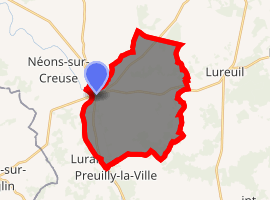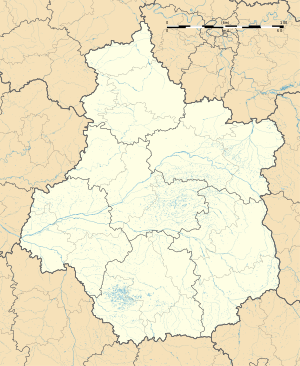Tournon-Saint-Martin
Tournon-Saint-Martin is a commune in the Indre department in central France.
Tournon-Saint-Martin | |
|---|---|
 The church of Saint-Martin, in Tournon-Saint-Martin | |
.svg.png) Coat of arms | |
Location of Tournon-Saint-Martin 
| |
 Tournon-Saint-Martin  Tournon-Saint-Martin | |
| Coordinates: 46°44′07″N 0°57′18″E | |
| Country | France |
| Region | Centre-Val de Loire |
| Department | Indre |
| Arrondissement | Le Blanc |
| Canton | Le Blanc |
| Intercommunality | Brenne Val de Creuse |
| Government | |
| • Mayor (2008–2014) | Dominique Hervo |
| Area 1 | 25.82 km2 (9.97 sq mi) |
| Population (2017-01-01)[1] | 1,159 |
| • Density | 45/km2 (120/sq mi) |
| Time zone | UTC+01:00 (CET) |
| • Summer (DST) | UTC+02:00 (CEST) |
| INSEE/Postal code | 36224 /36220 |
| Elevation | 64–140 m (210–459 ft) (avg. 80 m or 260 ft) |
| 1 French Land Register data, which excludes lakes, ponds, glaciers > 1 km2 (0.386 sq mi or 247 acres) and river estuaries. | |
Geography
The commune is located in natural region Boischaut Nord in the parc naturel régional de la Brenne.
The commune is located dat the limit of Indre-et-Loire departement (région Centre) and Vienne departement (Poitou-Charentes region ).
Antiquity
Tournon Saint Martin was an important crossroad. A Roman road crossed it, coming from Argenton-sur-Creuse ( Argentonmagus ) and going to Poitiers et Tours, following 'la Creuse' river.
Middle-Age
- Ruins of Prinçay Castle (xve siècle).
Population
| Year | Pop. | ±% |
|---|---|---|
| 1793 | 1,455 | — |
| 1800 | 1,248 | −14.2% |
| 1806 | 1,116 | −10.6% |
| 1821 | 1,318 | +18.1% |
| 1831 | 1,299 | −1.4% |
| 1836 | 1,398 | +7.6% |
| 1841 | 1,402 | +0.3% |
| 1846 | 1,505 | +7.3% |
| 1851 | 1,479 | −1.7% |
| 1856 | 1,456 | −1.6% |
| 1861 | 1,433 | −1.6% |
| 1866 | 1,513 | +5.6% |
| 1872 | 1,507 | −0.4% |
| 1876 | 1,505 | −0.1% |
| 1881 | 1,509 | +0.3% |
| 1886 | 1,622 | +7.5% |
| 1891 | 1,524 | −6.0% |
| 1896 | 1,581 | +3.7% |
| 1901 | 1,572 | −0.6% |
| 1906 | 1,562 | −0.6% |
| 1911 | 1,563 | +0.1% |
| 1921 | 1,514 | −3.1% |
| 1926 | 1,565 | +3.4% |
| 1931 | 1,584 | +1.2% |
| 1936 | 1,591 | +0.4% |
| 1946 | 1,581 | −0.6% |
| 1954 | 1,561 | −1.3% |
| 1962 | 1,589 | +1.8% |
| 1968 | 1,610 | +1.3% |
| 1975 | 1,589 | −1.3% |
| 1982 | 1,506 | −5.2% |
| 1990 | 1,374 | −8.8% |
| 1999 | 1,251 | −9.0% |
| 2006 | 1,223 | −2.2% |
| 2009 | 1,215 | −0.7% |
gollark: no.
gollark: Ideatic idea: make a THIRD general channel!
gollark: You should start fearing spirit.
gollark: ++delete gold
gollark: https://techcommgeekmom.files.wordpress.com/2016/09/img_0712.jpg
See also
References
- "Populations légales 2017". INSEE. Retrieved 6 January 2020.
| Wikimedia Commons has media related to Tournon-Saint-Martin. |
This article is issued from Wikipedia. The text is licensed under Creative Commons - Attribution - Sharealike. Additional terms may apply for the media files.